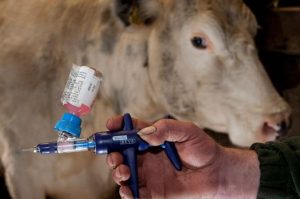
Vitamins For Cattles: Injections And Food Diet System
Vitamins For Cattles: Injections And Food Diet System
Apart from their daily food consumption, cattle also require at least seventeen different mineral elements in their diets. These minerals are usually of two types, macrominerals (significant minerals) and microminerals (trace minerals). Here, macro minerals are vital and include calcium, magnesium, phosphorus, potassium, sodium, chlorine, and sulfur. Likewise, microminerals are minimal; chromium, cobalt, copper, iodine, iron, manganese, molybdenum, nickel, selenium, and zinc are required.
All these minerals can be confined to an enormous vitamin supply such as A, D, and E. All these vitamins and minerals are needed for these cattles for their bone development, sight, and soft tissue maintenance. Likewise, often the absence of these nutrients causes reduced fertility, reduced bone density, and increased occurrence of disease and illness.
Altogether, these vitamins and minerals are stored in the liver, and cattle use them for two to three years.
How To Supplement These Vitamins And Nutrients?

Vitamins For Cattles
These vitamins supply can be injected into your cattle, and this process will last you for two to three months. However, if the weather is cold and the winter season is on the way, you should inject them twice.
While these are injected, vitamins A and D are mixed in a solution and injected, while Vitamin E is only administered enough to prevent the deterioration of the two vitamins.
However, you can also feed these minerals and nutrients in a grain mix. Yes, this is also one of the preferred methods where the cattle will get the vitamins needed every day. So, how many of these vitamins do the cattle need?
Indeed, if the vitamins and nutrients are forced to feed with a free choice daily, it can easily cause excess nutrients or deficiency. Hence, the intake must be monitored to ensure the correct level of the supplements.
Nutrients and Vitamins
Furthermore, when you feed the cattle with nutrients and vitamins, it depends on the age and size of the cattle. Additionally, before you inject them, you should check if the cattle are lactating or pregnant and their other health status.
Besides injection, other fat-soluble vitamins such as A, D, E, and K can be fed through their diet. You should have direct sunlight exposed to hay daily for vitamin D. This vitamin D is much more needed if the cattle are mostly left in a confined and covered facility. However, you can find vitamins A and E in a contained pack.
As a fun fact, if the feeding hay for the cattle is exposed to the air for more than 60-90 days, it eventually destroys the fat-soluble vitamins. This is frequent in baled hay, silage, and round bale silage.
How To Inject These Vitamins?
These injectable vitamins are antibiotics and anti-inflammatory drugs. These injections are not as simple as the insertion of the needle and release of these vitamins. They require proper administration to reduce injection-site lesions and the risk of side effects.
Before you inject, you should either talk with the veterinary and ask them for the details. Furthermore, it would help to read the labels to learn about the dosage and injection sites. While you do so, make sure to inject under the loose skin behind the shoulder of your cattle.
Hence, you should never inject the vitamins into their hindquarters, and a rump is a traditional location for intramuscular injections. This is because you can quickly locate the backside.
Likewise, we understand the trouble you can go through while injecting if the cattle are in a runaway situation. If so, you can use the squeeze chutes with neck extenders. Before injecting, you should put these on the cattle as it helps to reduce the risk of having your hand or arm injured, syringes smashed, or needles bent or broken.
Inject the Cattle
In addition to it, you should ensure your area is clean before the injection and also clean the cattle. Besides the cleanliness, you should have the appropriate needle size and length before injecting the vitamins.
Well, for a grown cattle with thick skin, you should use a larger-diameter needle (no smaller than 16-gauge). Similarly, if the cattle have thin skin, you should use a smaller-diameter needle (18-gauge).
Not to mention, the needle size also depends upon the consistency of the product. Here, the extent is necessary because the more significant the needle size, the more pain and the more chance of leaking the products.
Moving on, the length of the needles is crucial. If you want to administer intramuscular injections, you should use longer arrows, while for multiple-dose syringes, you should use shorter hands.
Why Is The Injectable Vitamins Necessary?
Among many of the vitamins and minerals needed in the cattle’s diet, vitamins A and E are the most important. And why? Vitamin A helps reduce the risk of retained placenta, and they should have an intake of 30,000 to 45,000 IU daily.
Usually, during the warm dormant seasons, the grasses are low in vitamins; hence, it raises the issue of vitamin deficiency. For cattle, vitamin A assists absorption, immune function, and cellular metabolism. Likewise, vitamin E helps with selenium.
What Happens If No Vitamins are Fed?
A simple answer to the simple question! If no needed vitamins are fed to the cattle, they suffer from deficiencies, which is one of the primary reasons why most young cattle die prematurely. Additionally, it also causes high stress.
Not to mention, the absence of these vitamins also causes an increased white muscle disease in newborn calves in extreme conditions.
